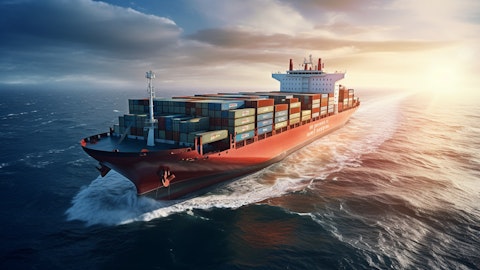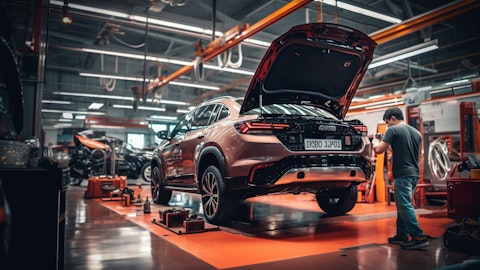Orion Engineered Carbons S.A. (NYSE:OEC) Q3 2025 Earnings Call Transcript November 5, 2025
Operator: Greetings, and welcome to the Orion S.A. Third Quarter 2025 Earnings Call. [Operator Instructions] Please note, this conference is being recorded. I will now turn the conference over to your host, Chris Kapsch, Vice President of Investor Relations. Please go ahead.
Christopher Kapsch: Thank you, Carrie. Good morning, everyone. This is Chris Kapsch, VP of Investor Relations at Orion, and welcome to our conference call to discuss third quarter 2025 earnings results. Joining the call are Corning Painter, Orion’s Chief Executive Officer; and Jeff Glajch, our Chief Financial Officer. We issued our third quarter results after the market closed yesterday, and we have posted a slide presentation to the Investor Relations portion of our website. We will be referencing this deck during the call. Before we begin, we are again obligated to remind you that some of the comments made on today’s call are forward-looking statements. These statements are subject to the risks and uncertainties as described in the company’s filings with the Securities and Exchange Commission, and our actual results may differ from those described during the call.
In addition, all forward-looking statements are made as of today, November 5, 2025. Orion is not obligated to update any forward-looking statements based on new circumstances or revised expectations. All non-GAAP financial measures discussed during this call are reconciled to the most directly comparable GAAP measures in the tables attached to our press release and the quarterly earnings deck. Any non-GAAP financial measures presented in these materials should not be considered as alternatives to financial measures required by GAAP. And with that, I will turn the call to Corning Painter.
Corning Painter: Good morning. Thank you, Chris, and thank you all for taking the time to join our conference call. Before getting into the Q3 review, I’m excited to announce that we’ve hired a new CFO, a replacement for Jeff, who previously announced his intention to retire. The formal announcement will be made shortly. We had a strong slate of candidates, both internal and external. We chose a candidate with 30-plus years of financial and business leadership experience, including the past 15 years in the chemical industry. He will start on December 1. Jeff has agreed to stay with Orion through the end of the year, and will be available for further transition support through Q1 2026. In today’s call, I’ll touch on Q3 results at a very high level, not the performance we expected, and certainly, we possessed much greater earnings power.
Still, there are some constructive points for investors to consider. Then I want to discuss the business environment, including recent headwinds. Cutting to the chase, our biggest challenge has been soft demand in our key markets. Various Specialty end markets are being impacted by global industrial activity malaise as reflected in soft PMI readings. In our normally resilient Rubber segment, and despite solid tire sell-through, tire production in our key markets is down. When compared to what we would consider more normalized levels, tire production in the U.S. is down about 29%, and the decline is 20% across Europe over the same time period, but closer to 35% in Western Europe. While there are reasons to believe demand will inflect positively, we are in no way counting on improved conditions.
We are taking action based on the current reality. Accordingly, we’re continuing to focus on self-help actions, the things we can control, some significant, that are intended to improve Orion’s structural cost and overall competitiveness. I’ll discuss more on this shortly. One key goal of these efforts is to ensure the company is generating positive free cash flow, should the headwinds persist. I’ll then hand the call to Jeff, who will review the third quarter financial results in more detail and discuss our free cash flow, [ revised ] guidance and some other items. Then I’ll have some concluding remarks before opening up the call to Q&A. On Slide 3, we broadly touch on the factors contributing to our Q3 performance. Adjusted EBITDA of about $58 million was slightly better than what we had conveyed in our mid-October preannouncement, but still well below expectations.
The largest factors were reduced Rubber segment demand in key Western regions, soft premium Specialty markets and fixed cost absorption variances across both segments, resulting from inventory control efforts. Because of lower oil prices, we also absorbed another inventory revaluation in the third quarter. Notably, our operating teams again delivered strong plant reliability throughout the third quarter. The sustained improvement in our operating performance is beneficial on a number of fronts, which I’ll touch upon in a moment. In our Rubber segment, our customers have been feeling pressure from elevated levels of imports. Tire imports, coupled with surplus channel inventories, have affected their production rates, and thus our carbon black demand.
Meanwhile, overall industrial activity softness has weighed on our Specialty business, and particularly end markets that usually consume our highest margin grades. In terms of the specific impact of this on Orion, remember, we are — historically, we’ve been over-indexed to both Western markets as well as to premium tire makers. While beneficial in prior cycles, this has not been ideal during 2025, but there are signs of change. Tier 1 players are adjusting their strategies to adjust — to defend share, including more innovation at the higher end, plant modernization efforts and more vigorously promoting their second-tier brands. The most recent 232 proclamation is another positive. Bigger picture. Western markets have been structurally dependent on tire imports for many years, if not decades, but at like half the tire sell-through at most, not the 70-plus percent from which imports have recently been seen.
As the channel rebalances towards historically more normalized level of imports, we will be very well positioned to benefit from a reversion in demand for our carbon black. In our Specialty segment, we have disproportionately deployed resources to drive customer qualifications with some of our newest and most differentiated conductive carbon products, and these efforts are bearing fruit. On this slide, we highlight a couple of qualifications now in place, with leading supply chain players in both the high-voltage wire and cable market and the battery energy storage space. Both applications are placed on the strong data center demand growth for power. This conductive portfolio, including our high-purity acetylene blacks, is our fastest-growing group of products, and their potential relevance in applications beyond traditional EV batteries is particularly encouraging.
On Slide 4, we share some updated data related to the key tire end market. We surmised the monthly import data for July was not unnoticed, given the volatility, there’s one data point spurred. Unfortunately, this is still the most recent U.S. import data available because of the government shutdown. Parsing this by category, one sees the largest contributor to the July increase was substantially higher truck and bus tire imports, which surged over 50% year-over-year in the month of July. We point this out because this import surge could reflect an effort by certain exporting countries to beat impending tariffs. Thailand, for example, is the largest exporter of truck and bus tires to the U.S. That country’s export data shows tire exports to the U.S. declining in August, the month when the country tariffs went into place for Thailand.
Meanwhile, the U.S. just invoked a new 25% Section 232 tariff on diesel truck parts that will unequivocally include truck and bus tires as of November. As Section 232 proclamations are uncontested, they should prove durable, and they supersede any country-specific reciprocal tariffs. In Europe, the tire industry continues to believe the EU’s investigation into exports by China into that region will result in an initial finding of dumping in December with some retroactive implications. Preliminary U.S., Canada and Mexico negotiations have begun around the USMCA trade agreement, which is poised for a reset effective July 1, 2026. As a reminder, Canada and Mexico are both net exporters of tires and carbon black to the U.S., and Orion does not have any production in either of these 2 countries.

Finally, we continue to believe the millions of dollars of capital commitments from major tire companies, focused on adding net unit capacity and modernizing existing production facilities, bodes well for North American fundamentals over the next few years. The implied production capacity growth of 3% through 2030 would be helpful, but their reshoring intentions are more telling. And obviously, the normalization in tire local production rates would be a more substantial driver of an earnings recovery for Orion. On Slide 5, we highlight actions that we have taken or are taking to navigate the current environment, 3 points here. First, while we believe tire manufacturing will rebound, we are not assuming any recovery in our key end markets. Second, to enhance our competitiveness, we’re implementing actions to further improve Orion’s overall cost structure.
Last quarter, we announced 3 to 5 underperforming production lines were being rationalized. Those actions will take place by the end of the year. We are looking more creatively at further optimization moves within our production network. Third, we’ve also reexamined our non-plant headcount, work processes, engagement with outside contractors, consultants, the company’s aggregate discretionary spend, amongst other things, and are in the process of further rationalizing costs across the board. Savings from this competitiveness effort will start to build in the current quarter and achieve a run rate savings in mid-2026. We’ll share more on the expected benefit when providing next year’s guidance in February. In parallel to this competitiveness issue, we’re also taking actions that benefit cash flow now.
A highlight for sure is the sustained improvement in our overall plant operating performance. This helps on a number of fronts. In addition to improved on-time customer service levels, better quality and reduced scrap, we’re also able to comfortably run our business with lower inventory levels, which in turn unlocks working capital. You can see the progress here in the past 2 quarters, and we expect a strong seasonal Q4 release, including, but not limited to, receivables, which should enable working capital to be a source of cash by approximately $50 million in 2025. The improved operating performance at our plant reflects our organization’s focused efforts on this front, but it’s also a function of our having worked down a backlog of previously deferred maintenance projects.
With the improved operating performance and with 3 to 5 fewer lines competing for maintenance capital, we’ll be able to further prioritize our maintenance spending and focus that spend on projects that ensure reliability at our most important production sites. This all feeds into our conviction around free cash flow generation despite the decline in EBITDA. Jeff will touch upon cash flow in more detail after his Q3 review. With that, I’ll turn the call over to Jeff.
Jeffrey Glajch: Thank you, Corning. On Slide 6, we show the overall company performance, both year-over-year and sequentially in the table, and compared with last year in the EBITDA bridge. Revenue was down 3% compared with last year despite 5% higher volumes. This was mostly a function of the contractual pass-through of lower oil prices, which have declined progressively throughout the year. Gross profit was 20% lower compared with last year despite the higher volumes. The most meaningful volume gains occurred in our lowest margin markets, while volumes declined in our more profitable Western regions. As a result of this dynamic, the lower demand in key regions and associated adverse fixed cost absorption were the biggest drivers of the profitability decline.
The fixed cost absorption had an effect of improving our working capital and increasing our free cash flow by reducing inventories. Also, an inventory revaluation tied to lower oil prices impacted gross profit as did adverse pricing. Finally, we had some favorable one-offs last year that did not repeat. On Slide 7, the Rubber business KPIs were directionally consistent with the overall company performance. Volumes were up 7%, but revenue was lower due to the oil-related pass-throughs. Gross profit declined compared with last year, primarily a function of the adverse geographic mix, reduced fixed cost absorption in key Western regions, pricing and customer mix as well as the aforementioned inventory revaluation. Higher volumes in the Asia Pacific and South American regions were related to our improved operational performance and annual contract outcomes, respectively, but these gains contributed minimally to EBITDA because our high-margin regions experienced lower volumes.
Compared with last year, costs increased due to inventory-related cost absorption, oil price-driven inventory revaluation and other timing effects. Slide 8. In Specialty, we had year-over-year and sequential volume gains, but the improvement was skewed towards lower-margin applications and products. In the coatings market, for example, a premium segment, demand was impacted by soft OEM vehicle builds and particularly with dispersion houses that can serve as swing capacity for the major coating companies when demand is stronger. More generally, we believe hesitant customer demand behavior, including continued just-in-time order patterns, reflect overall uncertainty. The biggest cost factor in Specialties EBITDA bridge was the adverse fixed cost absorption, largely a function of our inventory control efforts.
On Slide 9, we touch on a few other noteworthy items in the quarter. We recorded an $81 million noncash goodwill impairment charge. Our book value, which includes goodwill, is compared to the implied value of those assets when considering our enterprise value. On a positive note, we recovered $7.3 million of the 2024 fraud-related losses through legal actions and around $11 million to date. We continue to aggressively pursue recovery through a variety of legal means and insurance coverages. Finally, we completed an amendment to our credit agreement during the quarter, which increased our RCF capacity back to its prior level, expanded our bank group and gives us more overall flexibility in navigating the current business environment. On Slide 10, we depict our latest 2025 guidance including, the EBITDA range conveyed in mid-October and the corresponding adjusted EPS expectations.
Reflecting our current EBITDA guidance, along with better visibility on our progress with our working capital efforts, we expect positive full year free cash flow in the $25 million to $40 million range. Slide 11 shows our historic capital spending, including spending expectations for 2025. Notably, we do not have a figure for 2026 on this slide as we anticipate updating investors on this spend when providing a broader outlook in February. One fluid aspect is our ability to flex maintenance capital given our improving plant reliability. On Slide 12, you can see that we have achieved positive year-to-date free cash flow and expect further working capital improvements in Q4. As mentioned earlier, we expect full year free cash flow of $25 million to $40 million.
With that, I will hand the call back to Corning.
Corning Painter: Thanks, Jeff. I just want to close by reiterating a few key takeaways. While the case can be made that our business is at or close to trough conditions, or that a demand inflection should materialize, we are not depending on such a scenario. We are taking action. We have reduced working capital and expect a further progress in Q4 and into ’26. We’re taking additional cost out and working to further optimize our assets. Our objective is to increase Orion’s overall competitiveness and agility. This will serve us in combating the current headwinds, and when demand conditions normalize, we’ll be positioned to achieve even greater operating leverage. We’ll share more detail — a more detailed review on these initiatives in February. Underpinning all of these activities is our resolute focus on generating free cash flow. That is our highest priority. And with that, Carrie, let’s open up the line for our Q&A discussion.
Q&A Session
Follow Orion S.a. (NYSE:OEC)
Follow Orion S.a. (NYSE:OEC)
Receive real-time insider trading and news alerts
Operator: [Operator Instructions] And our first question will come from Josh Spector with UBS.
Christopher Perrella: It’s Chris Perrella on for Josh. Corning and Jeff, when I think about your volumes for 4Q and into 2026, what are your expectations there? And then a follow-up on how far along are you in the contract negotiations for next year? And what is that — so far, what does that imply for pricing and spreads in ’26?
Corning Painter: So our expectations for Q4, like the decline, if I’m comparing it to prior years, that’s pretty much all volume largely in that area. So we’re expecting people to take longer seasonal shutdowns, that kind of thing, and be managing down their own inventory in Q4. That’s the signal we have there. I think for next year’s volumes, in terms of manufacturing, as I indicated, there’s a case to be made that inflection is upon us, but we’re not counting on that. And I would say, in terms of negotiations, there, as we said and predicted last quarter, we didn’t see settling quickly in our interest. They continue to drag on. And I would say all in all, the negotiations are behind schedule compared to a more typical year. So I think in terms of exactly what’s going to be out there for next year in terms of volume, we’re really going to have to wait until we conclude the negotiations.
Christopher Perrella: I appreciate that. Anc can you just — what’s the impact of La Porte on volumes and earnings in 2026?
Corning Painter: I mean, volume-wise, it’s not a high-volume plant to begin with. And I think overall, with the start-up costs and all that, I would expect it to be negative in 2026.
Operator: And our next question comes from John Tanwanteng with CJS Securities.
Jonathan Tanwanteng: My first one, just assuming that import tire pressure is sustained through ’26 at ’25 levels, what is the potential for earnings improvement into ’26 in RCB just between — with all the movements you’re making in costs, your customers moving to more value positioning? Just help us understand what’s possible, the volumes are flat. And if you have any commentary on pricing spreads, that would be helpful.
Corning Painter: Yes. So I think the big question in 2024 is — or I’m sorry, 2026, is going to be the outcome of the negotiations, both the volume a particular company wins and the margins that come with that. I think that’s sort of like the big unknown. We will be working hard on some of the efficiency projects that I mentioned. But I think a big impact for next year is going to be the outcome of the negotiations. And it’s obviously commercially sensitive, and we are like in the middle of it right now.
Jonathan Tanwanteng: Okay. Great. And then do you have any expectations for Specialties next year, whether it’s market improvements, mix improvements? Just help us understand what your thoughts are on the Specialty side.
Corning Painter: All right. Well, we’ll do our — look, we’ll give our official guidance for next year in February. I think what will be guiding our views on that are, of course, what we hear directly from customers. I think you can get a sense of that by looking at how general manufacturing is going, where PMI goes. I would also say, OEM builds, right, that’s an important market for that space. So those will be — I think things you could look at that would give you a sense of how we see that business developing.
Operator: [Operator Instructions] Moving on to Laurence Alexander with Jefferies.
Kevin Estok: This is Kevin Estok on for Laurence. Just curious if you could give your thoughts around maybe what an industrial rebound would look like, I guess, let’s say, in 2026 or 2027? And I guess just curious what you think it takes to get us there?
Corning Painter: Sure. I mean — I think industrial recovery would say taking us back to things that looked more like pre-COVID. And I would think in that kind of environment, we’d find that we’re essentially nearly sold out in our key markets at that point, with strong demand coming from OEMs, strong demand from tire manufacturing, more normalized trade flows. I think the really positive thing here is that tire sell-through remains really solid. Tire sell-through is at the conditions I just mentioned, right? So it’s not like that is the fundamental challenge here. Yes, shipping, trucking activity is off a little bit, but passenger car is really quite strong. The big question is the success of our customers in the west around their own market share.
And of course, they’re being helped by trade policy right now. I think that’s a big one. I would say in the Specialty area, a pickup in construction, a pickup in automotive, those are things that would be very helpful and constructive in that area. Basically, the industrial economy getting back to a more normalized level.
Operator: I’m moving next to John Roberts with Mizuho Securities.
John Ezekiel Roberts: John Roberts for John Roberts again. Do you think the tire importers into the west are receiving government support or maybe lower raw materials, I don’t know, Russian rubber or Russian oil for carbon black that allows them to continue to import into the U.S. in spite of the tariffs?
Corning Painter: Well, I think if you look at it, the 232 tariffs, let’s say, of 25%, to be clear, that’s not going to be enough to totally price out imported tires. The U.S. and Europe cannot possibly make all the tires they need, right? Before all this happened, it was about 50% of the tires were imported to the U.S., very similar into Europe. So we’re never talking about, it has to get to a point where they are pushed out. What I think it has to get to the point where customers are more returning to their normalized brands. So one magazine recently published that just in October of this year, Tier 2 tires had the greatest demand. That’s more like normal conditions. The last — or so far this year, it had been Tier 3 tires that had the highest demand of the 4 tiers that they track.
So there’s a little bit there of customer sentiment moving back to a different value proposition in the tires they buy. And then number two, like the help in the tariffs is enough to like close the gap. So the gap between the Tier 2 and the Tier 3 and most Tier 1 companies have a Tier 2 brand. But that closes up to where people choose that value proposition. It’s — again, it’s like there’s no effort here. There’s no dream of pricing them all out, that’s impossible. But it’s a matter of just can you close the gap enough, the consumers will shift back. And I think that’s a concrete sign that, yes, this is all possible. This is all doable. And I think things tend to revert to their norm and perhaps this is the beginning of it, but we’re not going to count on that.
Jeffrey Glajch: John, I think you also — depending on the results of the antidumping situation in Europe, you may also see an impact from that. And that might give you some insight into either the profitability that they’re dealing with in the short term or even their willingness to operate at a very low or negative return.
John Ezekiel Roberts: Is it fair to say, it sounds like the recovery is more dependent on the lower-end consumer improving than it is on the tariffs? I mean the tariffs help, but it sounds like we need higher tire prices.
Corning Painter: Well, I think it’s 2 things. The point I would like to make, it’s not just relying on government action, right? There’s an element for industry, and there’s some certainly plus in the trade policy to overcome some of the, perhaps unfair disadvantages that are there that you mentioned earlier. I think the 2 of those together are important. But I would like to stress, I think industry and our customers, there’s a role there for self-help. They can continue to innovate on their top brands, make them more attractive, continue to approach their — to promote their second-tier brands, perhaps shift some production from one to the other. These are all things within their control and that you see some signs of them taking action in that direction, some more than others.
Operator: And we’ll take a follow-up question from Josh Spector with UBS.
Christopher Perrella: It’s Chris again on for Josh. From — as I think about next year, what are some of the recurring costs in 2025 that won’t be there in 2026?
Corning Painter: Well, so I think one thing that’s been with us all year long, I’ll let Jeff go into this, Chris. But I think one thing that’s been with us all year long has been the inventory adjustments. And that’s really a factor of the trend of oil pricing, and we pass that through, but there’s always an element of that. Should we just assume stable oil prices, then that would go flat for us. I mean if they went up, it would revert and go the other way. But I mean that’s certainly been a drag this year.
Jeffrey Glajch: Yes. If you think about it to date, we’ve taken our inventories down by $34 million. So that’s a pretty significant reduction in the inventory, and associated with it is the cost absorption related to pulling that inventory off the balance sheet and running it through the P&L. I think that’s the biggest thing. Going the other way, obviously, we’ve taken some cost out this year. Many of them are permanent, but there’s a variable comp component that’s not permanent, so that would have to add back in. But as Corning mentioned earlier, we have some pretty aggressive cost actions that we are going at currently and going into early 2026, that will help us reduce our costs next year and become more competitive.
Operator: This now concludes our question-and-answer session. I would like to turn the floor back over to Corning Painter for closing comments.
Corning Painter: Well, I’d like to thank you all for your time and attention today, and to thank everyone for their questions. They were insightful and useful, and I think, added value for all our investors. So thank you very much for that, and we look forward to be speaking with investors during the balance of this quarter. Thank you all. Have a good rest of your day.
Operator: And ladies and gentlemen, thank you for your participation. This does conclude today’s teleconference. You may disconnect your lines, and have a wonderful day.
Follow Orion S.a. (NYSE:OEC)
Follow Orion S.a. (NYSE:OEC)
Receive real-time insider trading and news alerts




